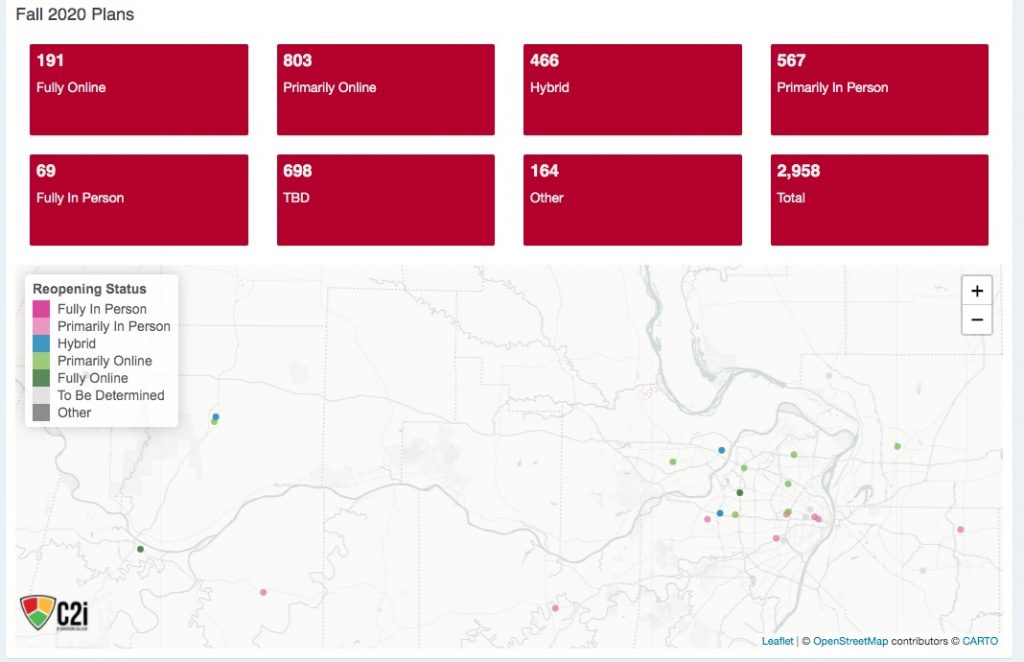As most of you know by now, I live in St. Louis. This is midway between two major rival state schools, in Columbia (Mizzou) and the University of Illinois at Urbana-Champaign. The two schools have markedly different Covid testing policies this semester. I will get to that in a moment, but first, take a look at this dashboard developed by the College Crisis Initiative:
 You can see the focus in my metropolitan area of each school and the various policies that have been adopted, ranging from full in-person classes to all-online instruction and various in-between choices. There is a lot of variation among the colleges and universities just on this small portion of the map. This reflects the variation of policies about the pandemic. In my region, we have different policies for mask wearing: a county just south of the city went from masks highly recommended to required to revoking the requirement, all within 24 hours. Such is the toxic mixture of politics and public health, with emphasis quite literally on toxic.
You can see the focus in my metropolitan area of each school and the various policies that have been adopted, ranging from full in-person classes to all-online instruction and various in-between choices. There is a lot of variation among the colleges and universities just on this small portion of the map. This reflects the variation of policies about the pandemic. In my region, we have different policies for mask wearing: a county just south of the city went from masks highly recommended to required to revoking the requirement, all within 24 hours. Such is the toxic mixture of politics and public health, with emphasis quite literally on toxic.
It is certainly a confusing time to be attending college. Mizzou is using a hybrid model: some in-person classes and some online. Each school’s dean makes their own decision. Students are required to report positive tests to the campus health department.
Illinois has gone whole-school testing. They aim to test everyone (including staff and faculty) twice a week, whether or not they show symptoms. They are doing thousands of free tests daily, using a new saliva-based protocol that was developed internally (Yale and the NBA are also doing something similar), with results available in minutes. Students receive results on an app on their phones, which allow them access to classrooms if they test negative. Interestingly, most of their classes are being held online, even though students are living on campus. All this planning didn’t help: students still went to parties and got infected.
Some schools, such as Notre Dame, began their semesters with plans for all in-person but got spikes in infections and then paused these classes to do more testing. The cause appeared to be a combination of large on-campus gatherings of non-mask wearers and two off-campus parties attended by biz school students. I guess the students took to their mirroring of adult life very faithfully.
To show you what shouldn’t be done is the example of Albion College in Michigan. Ironically, it has academic programs to train contact trackers to be hired by health agencies. Last month Zack Whittaker at TechCrunch wrote about a new Covid tracking app from Aura that is being deployed at the college. The app is mandatory for all students and tracks their real-time locations.
If you think you have already heard about Aura, there is another product with this name that is a mood tracker for the Apple Watch. There is also the Oura ring which is another health and activity monitor. But the Albion Aura app is a problem. Like at Urbana, students need to use the app to gain entry to classrooms. If students uninstall the app or don’t share their location with the app, they could be suspended. Its first release contained rookie security errors, one of which was found by one of the college’s compsci students. There is a long list of FAQs on the college website. I was more confused reading the entries and I can’t imagine what students and parents at Albion might think.
Clearly, we are all feeling our way through these trying times. And the Mizzou link above will take you to a SciAm piece that compares strategies at other schools. If you have a college student in your family, do share your own reactions here about your own perspective.
BU has this dashboard of their testing results. http://www.bu.edu/healthway/community-dashboard/
Pingback: Avast blog: Back to campus means understanding your data security | Web Informant